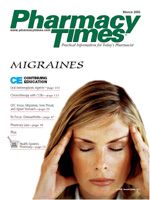Publication
Article
Pharmacy Times
A Pharmacist's Guide to OTC Therapy: Sore Throat
Author(s):
Sore throats most often are caused by an infection of the pharynx (pharyngitis). In ~90% of cases, the etiologies of these infections are viruses??such as influenza, adenovirus, and mononucleosis. They may be due to bacterial infections, however.1 Strep throat, also referred to as group A beta-hemolytic streptococci, is the most prevalent cause of bacterial infections in the throat. (Individuals with this type of infection should be referred to a physician.)
Common Causes
- Common cold
- Breathing through the mouth continually
- Influenza
- Viral pharyngitis
- Strep throat infection
- Draining from sinuses
- Inhalation of irritating chemical fumes or smoke
Treatments
Fortunately, many sore throats are minor in nature. Pharmacists can assess the specific symptoms described by the patient and make clinical interventions according- ly, based on this information. A plethora of OTC topical products currently are available. Many are in sugarfree form for diabetic patients.
Sore throat products are available as lozenges, sprays, gargles, and, most recently, pain strips that are applied directly to the tongue, providing immediate pain relief. These agents usually contain anesthetics, such as benzocaine and dyclonine hydrochloride, which provide temporary relief. Most of these products can be utilized every 2 to 3 hours. Other products available contain local antiseptics, such as cetylpyridinium chloride, hexylresorcinol, and/or menthol or camphor.2 Some products also may contain phenol.
Lozenges are the most commonly used OTC products for the treatment of sore throat pain. There are 3 main types: lozenges with a weak topical anesthetic, lozenges with menthol, and unmedicated lozenges (Tables 1-3).
New Sore Throat Products
Cepacol Lozenges for Sore Throat from Post Nasal Drip (Combe) contain 3 mg of the oral anesthetic menthol. This product works by countering throat soreness due to mucus drip. Pain relief is rapid. The product also provides menthol vapors, which help relieve nasal congestion. It is available in cherry and menthol flavors.
Chloraseptic Relief Strips (Prestige) are rapid-acting oral strips that contain 3 mg of both menthol and benzocaine. The product is recommended for use in adults and children ??5 years of age. Two strips are used per dose. The strip is placed on the back of the tongue to dissolve in the mouth. A second strip is used immediately after the first strip dissolves. A patient may use these strips every 2 hours as needed or as directed by a health care professional.
Other Recommendations for Patients
- Drink plenty of fluids, especially warm soothing liquids, or use cooling agents, such as popsicles or cold liquids
- Gargle with warm salt-water rinses
- Use hard candies to increase saliva production to ease irritation
- Utilize a humidifier or cool-mist vaporizer
- Get sufficient rest
After careful assessment of the patient's preexisting medical conditions and concurrent medication profile, the pharmacist also may recommend the use of OTC pain medications such as acetaminophen.
If sore throat pain persists for more than 2 days and is accompanied by or followed by a fever, rash, headache, nausea, and/or vomiting, pharmacists should instruct patients not to attempt to treat themselves.
Ms. Terrie is a clinical pharmacy writer based in the northern Virginia area.
For a list of references, send a stamped, self-addressed envelope to: References Department, Attn. A. Stahl, Pharmacy Times, 241 Forsgate Drive, Jamesburg, NJ 08831; or send an e-mail request to: [email protected].

Newsletter
Stay informed on drug updates, treatment guidelines, and pharmacy practice trends—subscribe to Pharmacy Times for weekly clinical insights.






